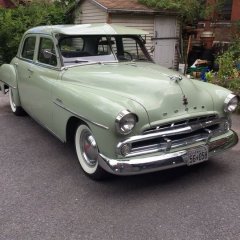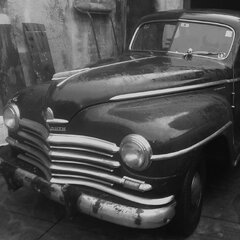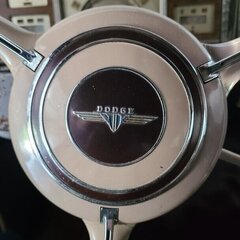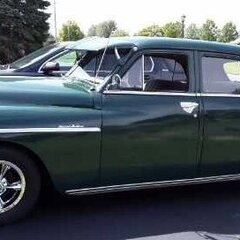-
Posts
6,167 -
Joined
-
Last visited
-
Days Won
134
Sniper last won the day on December 15
Sniper had the most liked content!
Reputation
2,716 ExcellentAbout Sniper
- Currently Viewing Forum: P15-D24 Forum
Contact Methods
-
Website URL
www.yourolddad.com
Profile Information
-
Gender
Male
-
Location
west Texas
-
My Project Cars
1951 Plymouth Cambridge
Converted
-
Location
nowhere
-
Interests
none
Recent Profile Visitors
5,174 profile views
-
I don't know enough to know if it reads lie data or not. The factory too is called DRB scan tool. In Ebay it's in excess of $2k. I did find the user manual online though, It doesn't specifically mention it can read OBD1 sensors
-

51 Dodge w/Edgy stuff on marketplace
Sniper replied to kencombs's topic in Ebay, Craigslist and External Site Referrals
Wow, I don't think you could buy the hot rod parts for anywhere near what he's asking for the whole car. -
The PCM sensor uses 5v from the PCM, it sends a voltage back to the PCM that varies depending on it's temperature and the PCM interprets that returned voltage as a temperature reading. OBD1 is not nearly as sophisticated as OBD2. Example: Coolant temp reads 50F, ambient reads 70F, intake air temp reads 125F. All are "valid" temperatures as far as the range of over all expectations go. After 5 minutes of running the coolant temp doesn't change. OBD1 thinks "it's in a valid range", OBD2 says "wait a minute", OBD2 knows that value should have gone up and based on load, run time, ambient temps and intake air temps has a pretty good estimation of where it should be and if it's not there will throw a code. OBD1 will not as it doesn't do that type of calculations. Now if the coolant temp sensor returns an invalid signal, such as not having 5v going to the sensor, OBD2 will throw a code. OBD1 might. This is really where being able to view the live data from that sensor comes in handy, One thing I found when putting together the parts for my EFI swap was a source that listed the data and values from the various sensors I am using. Microsquirt (my PCM) will let me look at that data live so I can see a flaky sensor that returns an "in range" value that is not correct. Such as telling me my coolant temperature is 50F, which is "in range" for that sensor, when it's actually past the thermostat opening temperature. Don't forget a grounded signal line from the sensor to the PCM will also confuse it. Unfortunately, I only have GM sensor data, but if we knew what the data was for your sensors we could back probe the voltage to the PCM and see if what's going there is rational or not.
-
Well, a good enough for government work type of guy maybe, lol. A wise man does what eases his mind.
-
Back then there were two coolant temps sensors, one for the gauge and one for the computer. If the one for the computer is sending bad data to the PCM then it may be the reason it's running rich. Essentially, it's telling the computer I am not warmed up so the computer stays in open loop and it runs rich once the engine is actually up to temperature. Gauge sender PCM sender OBD1 isn't sophisticated enough for you to actually look at the data and see if this is the case, unfortunately. OBDII is smart enough to let you do that, which cuts down on the issue of shotgunning parts, but at the expense of a costly scanner.
-
The only relay in the mopar injector circuit is the one that feeds 12v to all the injectors. The computer uses injector drivers (solid state device, not a relay) to trigger the injectors on/off via the ground. Those usually either work, or do not work, very rarely are they intermittent. Either the coolant temp sensor, the one for the computer not the dash gauge, is flaky, you have a leaky injector or the PCM is wonky. If you have the ability to measure the fuel pressure at the injector rails you can see how fast that pressure bleeds down, if it's quick you have a leaky injector(s). Have you run the codes?
-

Is my head gasket either blown or "blowing"?
Sniper replied to 1949plymouthdeluxe's topic in P15-D24 Forum
This right here. If you fill the radiator fully it will puke the excess out until it's happy. -
He said it's looks like someone ground on it, as in it is physically damaged. They should be replaceable, however you may have a problem finding SAE thread grease fittings in the Netherlands.
-
I ended up using some 1/2" ID thin steel shims to resolve that issue, I just used however many it took to get almost all the vertical free play out, Your local hardware store may carry them.
-
Yeah, sometimes the decision is made for you. One of the reasons I went HEI was cost, not to mention it is a superior design.
-
Yeah, my lawn mower is like that Sounds like you got it sorted. Evey car likes what it likes.
-
Manual chokes depend on the driver to use them properly. The last manual choke car I had, a 64 Chrysler 300, operated like this. Pull the choke knob out about a half inch, drive till it starts to bog and hesitate then push it all the way in and it ran fine. how long that took really depended on how cold it was. In San Diego, where I drove it most, it was rarely needed. When I went to radar school in Tennessee (winter there) it took a while to warm up enough to not needed. Of course that car had no flapper. But usually, by the time I got all the snow and ice off the windows it was most of the way there.
-
Cold weather related issues point me to one place to start The choke. Does it work and is it adjusted properly? Next place I would look is the exhaust flapper, does it work properly?
-
Yes, when I switched to my off hand to continue the whaling I about broke my shin with a near miss (not real coordinated as a lefty, lol).
-
Modern "vented" caps don't vent so well. Ran into that issue when I first bought by 51, I could hear the gas thank oil canning. Some drill a small hole in the lip of the fill tube, I modded my cap.









